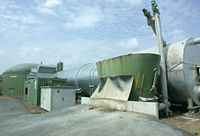
Photo from wikipedia
Purification of insoluble emulsified oils and soluble organic pollutants from sewage has attracted tremendous attention in today's society. Herein, a stable and environmentally friendly nanofibrous membrane with hierarchical caterpillar-like structure… Click to show full abstract
Purification of insoluble emulsified oils and soluble organic pollutants from sewage has attracted tremendous attention in today's society. Herein, a stable and environmentally friendly nanofibrous membrane with hierarchical caterpillar-like structure was fabricated via in-situ hydrothermal growing the nickel-cobalt layered double hydroxides (NiCo-LDHs) on tche polyacrylonitrile (PAN) electrospun nanofibers. The wrapped hydrophilic NiCo-LDHs constructed the hierarchical structure and endowed the membrane attractive superhydrophilicity (≈ 0°)/underwater superoleophobicity (≈ 161°) and enhanced oil-repellency performance. Meanwhile, the NiCo-LDH@PANI/oPAN NFMs can display the ultra-fast flux of SSEs (xylene/water emulsion, 4175 L m-2 h-1) and satisfactory separation efficiency (99.07%). Moreover, the introduction of positively charged NiCo-LDHs increased plentiful adsorption active sites for membranes, which is beneficial to demulsify ionic SSEs and adsorb organic pollutants. Finally, for simultaneous purification of complex sewage by the dead-end and cross-flow filtration experiment, the composite membrane both displayed splendid removal rate of oil (> 99.0%) and dyes (> 99.0%), robust regeneration recycle-ability and no secondary pollution. Hence, it is expected that such strategy of combining electrospun and chelating-assisted in-situ hydrothermal can provide a low energy consumption and high decontamination technology for severe environmental crisis.
Journal Title: Journal of hazardous materials
Year Published: 2021
Link to full text (if available)
Share on Social Media: Sign Up to like & get
recommendations!